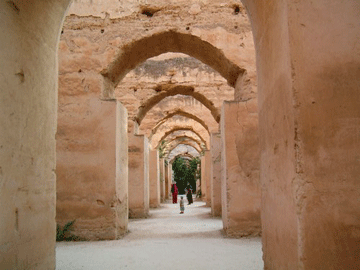
Scene in Meknes, Morocco
by Emilio Spadola
Colgate University
Dept of Sociology and Anthropology
Recently, my efforts to think on Moroccans’ quality of modern (i.e., mass-mediated) life have turned on violence both there and in the US, and, especially, to two forms of youth violence: suicide bombings and suicide shootings. In 2007 Moroccans witnessed separate bombings in Casablanca and Meknes; in separate cases Moroccan state intelligence traced other accused suicide bombers to one neighborhood in Tetouan. In the US in December an Omaha teenager with an automatic weapon shot and killed eight mall goers, then himself; four deaths shortly after in Colorado added to the long year of suicide sprees by young men: six deaths in a Utah mall in February, 33 deaths on the Virginia Tech campus in April.
Emphasizing putative differences, cultural pundits habitually link suicide bombings to the Middle East, and, specifically, to an Islamic culture of violence. And shooting sprees seem typically, if pathologically, American. They are nonetheless strikingly redolent. Yet to compare them, that is, to abstract them from their separate contexts, takes special care. In so doing one faces what Benedict Anderson calls the “specter of comparisons,†that is, the distinctly modern moment in which persons appear, like commodities and print, as serial copies. Yet it is precisely this imagined quality of commensurability—when “anyone†rather than a specific someone can be a target (of mass-mediated messages)—that marks as contemporary suicide bombing and suicide shooting.
These kinds of violence are complicit with the age; first of all, in the adamant anonymity of the public victims. Neither the bombing nor the shooting is a crime of passion in the ordinary sense. Rather, the killers lack all intimacy with the killed, who are identifiable perhaps only as the enemy—or the audience. The particular victims are not selected but are merely accidental; the bullets or body parts and shrapnel are sprayed indiscriminately like a broadcast signal.
The resemblance of the killing to broadcast is indeed critical, for it reminds us that the killer achieves a renown the victims lack. The kinds of messages often accompanying—or extending—each act suggest a desire for recognition which the killer is denied in everyday life. The Virginia Tech killer sent a multimedia package to NBC; the Omaha killer’s suicide note expressed his wish to be famous. One thinks of the production and distribution of martyr videos and posters in Lebanon and Palestine. Although to my knowledge such documents are absent in the Moroccan cases, political scientist Abdelhay Moudden has described these bombings too as messages, imagining the Casablanca bombers to say, “Look at me. Look at my body in pieces on the ground.â€
To be sure, this structural comparison is only one element of an exceedingly difficult question. In terms of motivation, further analysis should distinguish very strongly between suicide bombings in Palestine, Lebanon, Iraq, Afghanistan, and elsewhere—that is, as tactics of protracted wars—and those bombings in Morocco, which extend violence to another public in their name. Their differences may yet rest on their similar structures, however; for whereas facile culturalism—ascribing politics to a putative socialization—would separate them, suicide shootings and bombings are akin in placing their anonymous victims within their mass audience.
[Dr. Spadola received his Ph.D. in Anthropology from Columbia University, based on ethnographic research in Morocco.]